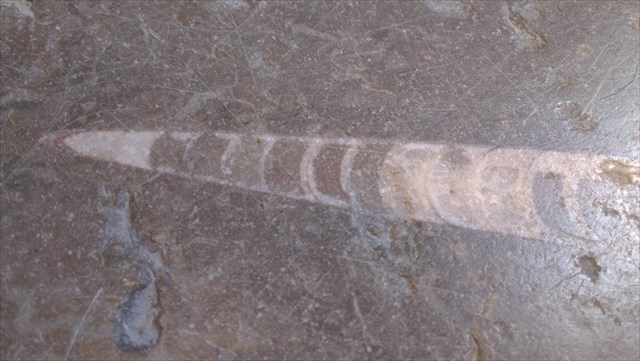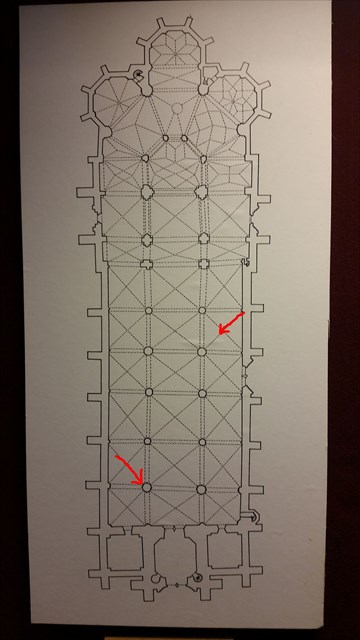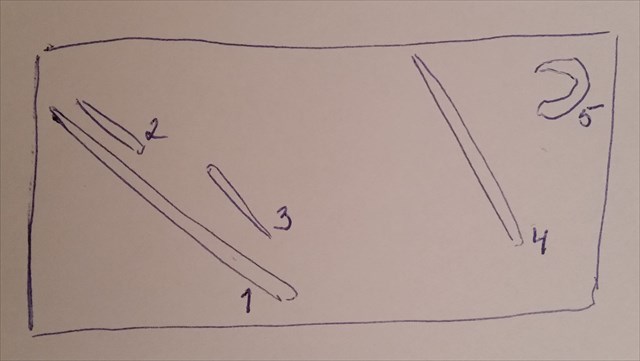Svenska (English below)
I Linköpings domkyrkas golv finns ett antal gamla gravstenar men där finns också spår av betydligt äldre döda än så. Bevarade i stenarna som bildar golvet finns även en hel del ortoceratiter som är ett slags fossil man ofta ser i kalksten.

Det vi i dagligt tal kallar för sten delas upp i tre huvudsakliga kategorier:
- Magmatiska bergarter: bildas av att lava stelnar till sten.
- Metamorfa bergarter: bildas av att existerande bergarter omvandlas till andra typer genom inverkan av högt tryck och temperatur.
- Sedimentära bergarter: bildas genom att sediment omvandlas till sten genom en process som kallas för diagenes.
Fossil är växt- eller djurdelar som bevarats i sediment. Allt eftersom tiden gått och sedimentlagret blivit tjockare så har det börjat påverkas av ett antal olika processer som till slut leder till att det omvandlas till sten. Först sker kompaktion vilket helt enkelt innebär att underliggande lager pressas ihop av vikten av de nya lager som avlagras ovanpå dem. Nästa fas i omvandlingen innebär att det sker kemiska utfällningar mellan mineralkornen (så kallad cementering) vilket gör att mineralkornen binds ihop. För att det ska bildas en sedimentär bergart så krävs att den här processen sker under en relativt låg temperatur (150-200 grader eller lägre). Om temperaturen är högre så bildas istället metamorfa bergarter.
Det finns också flera olika typer av fossiler. Ibland hittar man bara ett avtryck av djuret eller växten, andra gånger kan organismen ha bevarats men fångats inuti mineraliserat sediment, men i den sort som syns här (och som nog är mest välkänd) så har även resterna av djuret omvandlats till sten.

De djur man kan se i kyrkgolvet är ortoceratiter. De är ett slags nu utdöda bläckfiskar som levde från början av Ordovicium (490 miljoner år sedan) till slutet av Trias (240 miljoner år sedan).
Ortoceratiter hade ett strutformat skal bestående av successivt större kamrar. Allt eftersom djuret blev större byggdes fler kamrar på i den bredare änden och äldre delar slöts till. Det var vanligt att de äldsta kamrarna (spetsen av skalet) liksom de nedre delarna av varje kammare fylldes med kalkspat vilket bildade en primitiv "köl" och underlättade djurets navigering. De exakta mönstren för denna ifyllnad kan användas som en av ledtrådarna för att lista ut vilken art ett fossil tillhör.
 Medan de levde så var ortoceratiterna snabba rovdjur som i första hand simmade baklänges. När de så småningom dog sjönk de till botten tillsammans med diverse andra avlagringar som genom åren omvandlats till sten och därmed bevarat djuren så att vi kan se dem idag. De är vanliga i kalksten, och kan därmed ofta ses i gamla golv och andra byggnadsdetaljer. Själva ortoceratiten levde i huvudsak i den grövre änden av sitt skal men den hade också en avlång kroppsdel, sifonen, som sträckte sig ut i de äldre delarna av skalet och kunde användas för att pumpa vatten eller kroppsgaser till skalet för att variera lyftkraften hos skalet.
Medan de levde så var ortoceratiterna snabba rovdjur som i första hand simmade baklänges. När de så småningom dog sjönk de till botten tillsammans med diverse andra avlagringar som genom åren omvandlats till sten och därmed bevarat djuren så att vi kan se dem idag. De är vanliga i kalksten, och kan därmed ofta ses i gamla golv och andra byggnadsdetaljer. Själva ortoceratiten levde i huvudsak i den grövre änden av sitt skal men den hade också en avlång kroppsdel, sifonen, som sträckte sig ut i de äldre delarna av skalet och kunde användas för att pumpa vatten eller kroppsgaser till skalet för att variera lyftkraften hos skalet.
I svensk kalksten förekommer fossil av några olika familjer av ortoceratiter: Orthoceratidae med en tunn centralt placerad sifon, Endoceratidae med en kraftig sifon placerad mot skalets nedre del och Actinoceratidae med en kraftig sifon som sväller ut i den enskilda kamrarna.
Frågor att svara på för att få logga cachen
 Den här cachen är placerad med tillstånd av Domkyrkogruppen i Linköping.
Den här cachen är placerad med tillstånd av Domkyrkogruppen i Linköping.
För att logga den här cachen behöver du gå in i Linköpings domkyrka. Den är öppen 9-18 de allra flesta dagar (men det kan hända att arrangemang pågår och då är det så klart inte lämpligt att försöka logga cachen).
 Det finns ortoceratiter av olika storlekar lite överallt i kyrkans golv men för frågorna finns det två ställen vi ska titta på lite närmare. Plats A är ungefär mitt mellan den fjärde och femte raden pelare från ingången räknat och ungefär mitt i gången till höger. Om du ser en krokig ortoceratit i det övre högra hörnet av golvplattan (från ingången sett) så tittar du på rätt golvplatta (se skiss). Plats B är precis bakom den första pelaren till vänster från ingången räknat, precis intill hörnet av gravstenen i golvet.
Det finns ortoceratiter av olika storlekar lite överallt i kyrkans golv men för frågorna finns det två ställen vi ska titta på lite närmare. Plats A är ungefär mitt mellan den fjärde och femte raden pelare från ingången räknat och ungefär mitt i gången till höger. Om du ser en krokig ortoceratit i det övre högra hörnet av golvplattan (från ingången sett) så tittar du på rätt golvplatta (se skiss). Plats B är precis bakom den första pelaren till vänster från ingången räknat, precis intill hörnet av gravstenen i golvet.
- På plats A hittar du några olika ortoceratiter (se skiss ovan för att vara säker på att du tittar på rätt stenplatta). Förklara hur avlagringarna av kalkspat i skalen på nummer 1 och nummer 4 skiljer sig åt. Spekulera gärna även i vad den här skillnaden skulle kunna bero på
- Jämför nummer 3 och nummer 4 på plats A. De har båda många vita ringar men det skiljer mycket i hur breda ringarna är. Varför det, tror du?
- På plats B, precis intill gravstenens hörn, finns en rätt tjock ortoceratit. Vilken familj tror du att den tillhör?
- Vilka är de största och minsta ortoceratiter du kan hitta i golvet (diameter och längd)?
- Frivillig bonusfråga: Vad tror du att de som byggde Linköpings domkyrka för ungefär 1000 år sedan trodde att fossilen var?
Skicka svaren till mig via min profil (skriv dem inte i loggen). Det går utmärkt att logga direkt när du har skickat in dina svar. Om något skulle vara fel så hör jag av mig, men annars inte.
English
Set in the floor of Linköping cathedral are several old tombstones, but there can also be seen traces of much older dead than that. Preserved in the stones making up the floor are also a number of fossils called Orthocerida, often seen in limestone.

What we commonly call rock is divided into three main categories:
- Igneous rock: created when lava hardens to stone.
- Metamorphic rock: created when existing rocks are transformed to other types of rock through the influence of high pressure or temperature.
- Sedimentary rock: created by sediment being transformed to stone by a process called diagenesis.
Fossils are pieces of plants or animals that have been preserved in sediments. As time passes and the layer of sediment gets thicker it has begun to be affected by a number of different processes that finally will lead to it being transformed to rock. First comes compaction which simply means that lower layers are being pressed together by the weight of the layers on top of them. The next phase in the transformation means that there are chemical precipitations between the mineral grains (called cementation) causing the mineral grains to be attached together. In order for a sedimentary rock to be formed, this process needs to happen at a relatively low temperature (150-200 degrees or lower). If the temperature is higher, metamorphic rock will be formed instead.
There are also different types of fossils. Sometimes only an impression of the animal or plant is formed, while at other times the organism has been preserved but captured within mineralized sediment, but in the kind of fossil seen here (and which is probably the one most well-known), the remains of the animal have also been transformed into rock.

The animals seen in the floor are orthocerids. They are a kind of now extinct octopuses that lived from the beginning of the Ordovician (490 million years ago) to the end of the Triassic (240 million years ago).
Orthocerids had a conical shell consisting of successively larger chambers. As the animal grew bigger, more chambers were added in the wider end and older parts were closed off. It was common for the oldest chambers (the tip of the cone) as well as the lower parts of each chamber to be filled with calcite which formed a primitive "keel" that helped the animal navigate. The exact patterns for these accretions can be used as one of the clues when figuring out what species a fossil belongs to.
 While they were alive, orthocerids were quick predatrors that primarily swum backwards. As they dies, they sunk to the bottom together with various sediments that over many years transformed to rock, preserving the animals so that we can see them today. They are common in limestone and can thus often be seen in old floors and other architectural details. The orthocerid itself primarily lived in the wider part of its shell but it also had a strand of tissue, the siphuncle, stretching into the older parts of the shell that could be used to pump water or body gases to the shell to vary the buoyancy of the shell.
While they were alive, orthocerids were quick predatrors that primarily swum backwards. As they dies, they sunk to the bottom together with various sediments that over many years transformed to rock, preserving the animals so that we can see them today. They are common in limestone and can thus often be seen in old floors and other architectural details. The orthocerid itself primarily lived in the wider part of its shell but it also had a strand of tissue, the siphuncle, stretching into the older parts of the shell that could be used to pump water or body gases to the shell to vary the buoyancy of the shell.
In Swedish limestone can be found fossils of a few different families of orthocerids: Orthoceratidae that have a thin centrally placed siphuncle, Endoceratidae with a thick siphuncle placed in the lower part of the shell and Actinoceratidae with a heavy siphuncle that extends into the different chambers.
Questions to answer to be allowed to log the cache
 This cache is placed in cooperation with Domkyrkogruppen i Linköping.
This cache is placed in cooperation with Domkyrkogruppen i Linköping.
To log this cache you need to enter Linköping Cathedral. It is open 9-18 most days (but events may take place, in which case it is not a good idea to attempt to log the cache).
 There are orthocerids of different sizes all over the church floor but for the sake of these questions there are two places to study. Place A is approximately in the middle of the space between the fourth and fifth row of pillars from the entrance, approximately in the middle of the right corridor. If you see a curved orthocerid in the upper right corner of the stone (seen from the entrance) you are looking at the right stone (see sketch). Place B is just behind the first pillar to the left from the entrance, just next to the corner of the tombstone in the floor.
There are orthocerids of different sizes all over the church floor but for the sake of these questions there are two places to study. Place A is approximately in the middle of the space between the fourth and fifth row of pillars from the entrance, approximately in the middle of the right corridor. If you see a curved orthocerid in the upper right corner of the stone (seen from the entrance) you are looking at the right stone (see sketch). Place B is just behind the first pillar to the left from the entrance, just next to the corner of the tombstone in the floor.
- At place A you will find a few different orthocerids (see sketch to be certain that you are looking at the right ones). Explain how the deposits of calcite in the shells differ between number 1 and number 4. Please also speculate on how this difference appeared.
- Compare number 3 and number 4 at place A. They both have a lot of white rings but they differ a log in how wide the rings are. Why, do you think?
- At place B, just next to the corner of the tombstone corner, there is a rather thick orthocerid. Which family do you think it belongs to?
- Which are the largest and smallest orthocerids that you can find in the floor (diameter and length)?
- Optional bonus question: What do you think the builders of Linköping cathedral thought the fossils were, approximately 1000 years ago?
Send your answers to me via my profile (don't write them in your log). Feel free to log the cache immediately after sending me your answers. If there are any problems with your answers I will get back to you, but otherwise not.